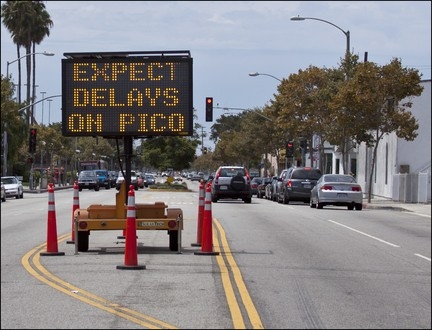
SMC — Santa Monica College will be opening its doors Monday for the fall semester, and all Santa Monica public schools will open Tuesday. For residents in some areas, that means one thing: traffic.
The schools don’t normally open at the same time.
“It’s one of the first times it’s happened in about 20 years. It’s very unusual,” said Genevieve Bertone, director of sustainability at Santa Monica College.
The synchronized start date is part of the Santa Monica-Malibu Unified School District’s plan to give students more time to study for AP and mandated exams.
SMC shares Pearl Street with John Adams Middle School, and is near Grant Elementary and Will Rogers Learning Community. Santa Monica High School is down Pico Boulevard.
The college always participates with traffic authorities to facilitate traffic in the neighborhood, Bertone said. City road signs have already been placed on Pico warning travelers to expect delays starting Monday.
“We know the extra traffic’s going to be a burden to people coming into Santa Monica, to residents in Santa Monica,” said Santa Monica Police Department’s Sgt. Jaime Hernandez, supervisor of neighborhood resource officers.
To help the college prepare for the congestion, police trained college personnel to provide traffic control, Hernandez said. SMC personnel will cover the corners of Pico and Pearl.
For the first two weeks, police will be assisting the college with traffic control in the greater bottleneck areas, he added.
“After a couple of weeks, it’ll get into a routine,” Hernandez added.
SMC and traffic services were expecting that there would be traffic in the fall for the past few months, Hernandez said.
Fliers were distributed by the college in the neighborhood surrounding the main campus, informing residents about the expected congestion.
In the summer, SMC launched an advertising campaign to educate students about alternative forms of transportation, Bertone said.
The college sent out postcards and e-mails to registered students, something that SMC doesn’t normally bother with.
The e-mail offered tips on avoiding traffic, such as taking the Big Blue Bus, carpooling or parking at a satellite campus and commuting to the main campus.
Driving to the main campus might be difficult, especially for new students.
“Students are already nervous and scared, we don’t want parking and transportation to be another barrier to pursuing their educational goals,” Bertone said.
SMC students can still ride the BBB for free during the fall semester. This is the third year BBB has offered free rides to students with a current SMC ID.
To encourage biking, SMC has partnered with Bikerowave, a Los Angeles-based bicycle repair shop. Students with a valid SMC ID can get some free services from the shop, Bertone said.
If students cannot bike or take the bus, they should make arrangements to carpool, Bertone said.
“There’s no reason you should drive alone,” she said, citing the positive effect carpooling has on the environment and at the gas pump.
A new program the campus is offering is Zimride, a San Francisco-based online social networking system that matches riders and drivers for carpools.
SMC is the first community college to use the Zimride program, which is already being used by UCLA, Bertone said.
“It’s like Match.com for drivers,” she said. “You go on, upload your profile.”
Profiles on Zimride include information on where you’re coming from and when you want to arrive on campus.
You can also upload more personal information, including what music you like to listen to and whether you smoke in the car, Bertone said.
“Things that really impact your commute,” she added.
Even carpools could have trouble finding parking, Bertone said.
The neighborhood around the campus is preferred parking, and normally parked cars without permits are ticketed.
Bertone hopes that students will follow the college’s advice, and get out of their cars to be greener commuters and reduce congestion. In doing so, they will be better citizens globally and locally, she said.
“That starts right here with being a good neighbor,” she said.
Hernandez had this advice for students and residents.
“For the first couple of weeks, be a little patient,” he said.
news@www.smdp.com
Editor's note: A previous version of this story incorrectly stated that students without preferential parking placards who park their vehicles on streets around Santa Monica College that have restrictions would not be ticketed for two weeks. Those without placards will be ticketed by police. Some leeway was given in the past, but not this time around, according to police.








